Mark Lawson and Andrew Way of the Steel Construction Institute (SCI) discuss issues related to fire resistance of buildings and introduce upcoming new SCI guidance on the fire resistance of light steel framing.
Since the Grenfell fire disaster, the question of the fire safety of medium and high-rise residential buildings has been heightened. Clients and checking authorities are understandably concerned about fire safety, particularly for buildings that exceed 18m in height, and Regulations have been introduced to prevent the use of combustible materials in external walls. SCI has been working with members of the Light Steel Forum and other industry experts to update design guidance on the fire resistance of light steel framing which is well established as a construction system for medium-rise residential and mixeduse buildings.
Steel has well-known properties at elevated temperatures and comprehensive design data is presented in BS EN 1993-1-2 and formerly in BS 5950-8 (dating from 1990). BS 5950-8 was the first fire engineering code worldwide and it influenced Eurocode developments. The critical temperature of structural steel beams and columns is taken as 550°C for the design of the fire protection to these members and this critical temperature increases as the proportionate loading (known as the load ratio) on the member reduces. Structural engineers are familiar with the design approach for structural steel but the application of methods for cold formed steel is the subject of the recent work by SCI.
Light steel framing has gained a market share because one of its benefits is that it is non-combustible and does not add to the fire load of the building, which are in addition to its other benefits. It may be used with joisted floors or increasingly, with composite floor slabs that are supported by the light steel loadbearing walls.
Strength Retention of Cold Formed Steel Cold formed steel has slightly reduced strength retention properties at elevated temperatures compared to structural steel H sections and hollow sections because of the influence of local buckling of its thin profile. Nevertheless, the strength reduction factor (SRF) for Class 4 sections at 500°C is still 0.53 of the nominal yield strength. This means that a light steel section can support the reduced loads at the fire limit state up to this slightly lower critical temperature.
Light steel framing differs from structural steel in that it is a planar construction system. The 2D walls and floors are protected by layers of Type F or similar fire rated plasterboards. In the last three years, an unprecedented number of loaded fire tests have been performed by light steel framing and plasterboard suppliers to satisfy 60, 90 and 120-minutes fire resistance requirements for loaded walls and floors.
A fire test on a loaded wall is generally performed using the thinnest steel section in a range with the highest sensible load that can be applied by the test house. Temperatures are measured on the flanges and web on the C sections at a number of positions, so that the critical temperatures can be related directly to the load that is applied for the particular wall build-up. This is the socalled ‘load ratio’ method.
With this test information, the design of a C section with thicker steel or with another wall height from that tested can be calculated using the method developed by SCI. The only issue that affects the design solution is then the effect of non-uniform heating through the C section for fire on one side, which has two opposing effects: it causes some thermal bowing which adds to bending effects (or P- effects); but on the beneficial side, the centre of resistance of the C section moves towards the cooler unexposed flange. Generally the two effects can cancel each other for the normal range of wall lengths but the loss in buckling resistance due to thermal bowing is taken into account.
To read full article, go to Offsite Magazine issue 27!









